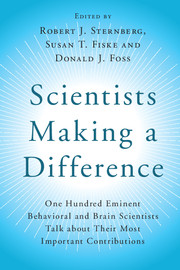 Scientists Making a Difference
Scientists Making a Difference Book contents
- Frontmatter
- Contents
- List of Contributors
- Foreword: Making a Creative Difference = Person × Environment
- Preface
- Part I Introduction
- Part II Biological Bases of Psychology: Genes, Brain, and Beyond
- Part III Cognition: Getting Information from the World and Dealing with It
- Part IV Development: How We Change Over Time
- Part V Motivation and Emotion: How We Feel and What We Do
- Section A Motivation
- 58 The Motivation for Creativity
- 59 Inner Processes Serve Interpersonal Functions
- 60 Self-Regulation
- 61 Intrinsic Motivation: The Inherent Tendency to Be Active
- 62 Mindsets: From the Classroom to the Middle East
- 63 Whether You Think You Can, or You Think You Can't – You're Right
- 64 Promotion and Prevention Motivations
- 65 The Letter to a Friend That Helped Launch a Career
- 66 The Empirical Study of Human Autonomy Using Self-Determination Theory
- 67 Behavioral Self-Regulation: A Little Optimism Goes a Long Way
- 68 The Affective Revolution of the 1980s
- Section B Emotion
- Part VI Social and Personality Processes: Who We Are and How We Interact
- Part VII Clinical and Health Psychology: Making Lives Better
- Part VIII Conclusion
- Afterword: Doing Psychology 24×7 and Why It Matters
- Index
- References
62 - Mindsets: From the Classroom to the Middle East
from Section A - Motivation
Published online by Cambridge University Press: 05 August 2016
- Frontmatter
- Contents
- List of Contributors
- Foreword: Making a Creative Difference = Person × Environment
- Preface
- Part I Introduction
- Part II Biological Bases of Psychology: Genes, Brain, and Beyond
- Part III Cognition: Getting Information from the World and Dealing with It
- Part IV Development: How We Change Over Time
- Part V Motivation and Emotion: How We Feel and What We Do
- Section A Motivation
- 58 The Motivation for Creativity
- 59 Inner Processes Serve Interpersonal Functions
- 60 Self-Regulation
- 61 Intrinsic Motivation: The Inherent Tendency to Be Active
- 62 Mindsets: From the Classroom to the Middle East
- 63 Whether You Think You Can, or You Think You Can't – You're Right
- 64 Promotion and Prevention Motivations
- 65 The Letter to a Friend That Helped Launch a Career
- 66 The Empirical Study of Human Autonomy Using Self-Determination Theory
- 67 Behavioral Self-Regulation: A Little Optimism Goes a Long Way
- 68 The Affective Revolution of the 1980s
- Section B Emotion
- Part VI Social and Personality Processes: Who We Are and How We Interact
- Part VII Clinical and Health Psychology: Making Lives Better
- Part VIII Conclusion
- Afterword: Doing Psychology 24×7 and Why It Matters
- Index
- References
Summary
When I was in college, I fell in love – with the scientific method. Could I imagine a better career than using the scientific method to uncover the workings of the human psyche? No, and I still can't. It's been a long and fruitful relationship, and I'd like to share with you some of the fruits.
My most important scientific contribution so far has been my research on mindsets. (From now on I will say “our” and “we,” because all of the research is collaborative, which makes the enterprise all the more stimulating and enjoyable. We are not lone scientists toiling in isolation.) It all started with the following question: What makes some people seek challenges and thrive in the face of obstacles, while others, no less able, avoid difficulty and crumble when they encounter setbacks? I came to realize that I was interested in this question for personal reasons. Many of us psychologists do not just do research, but what we call “me-search” – research on a topic that is really about us, such as our bad memory or our inability to exert willpower or our concern with others’ opinions. As for me, I had always done well at everything I tried, but I didn't try everything. I was reluctant to step out of my comfort zone and was alarmed by the prospect of ever failing at anything I valued. As I began my me-search, I encountered something that would change me for good.
While working with ten-year-old students, at some point in the experiment I gave them problems that were too hard to solve. As I expected, some students were a bit distraught. But, counter to my expectation, some were pleased. They didn't just cope with what I thought of as the “failure” problems, they welcomed them as an exciting opportunity to learn. It was as though the whole experience was now worth their while. After I got over my shock, I vowed to understand these children's secret, not just for myself, but so I could share it with others.
Some years later, we came to understand that these students were in a “growth mindset.
- Type
- Chapter
- Information
- Scientists Making a DifferenceOne Hundred Eminent Behavioral and Brain Scientists Talk about Their Most Important Contributions, pp. 293 - 296Publisher: Cambridge University PressPrint publication year: 2016
References
- 1
- Cited by
